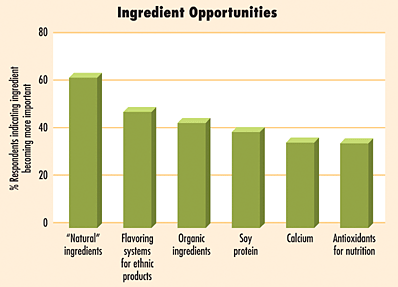
Our exclusive R&D survey asked what ingredients would become more or less important to companies' products within the next two years. The top ingredients that respondents indicated a growing interest in included those regulated as natural, flavors for ethnic systems, organic ingredients, soy protein and antioxidants for nutrition. Here is a brief look at these ingredients and what they will offer formulators for future product development endeavors.
All Natural and Organic
Organic ingredients and ingredients regulated as natural continue to peak our respondents' interest. (See chart, page 35). While consumers increasingly turn towards healthier lifestyles, they often perceive all-natural products and organic products as healthier than products containing artificial ingredients. In addition, consumers want authenticity and freshness in prepared foods. A “clean,” all-natural label comes across as “less-processed” to consumers.The term “natural” has not been defined in FDA's law (the Federal Food, Drug, and Cosmetic Act) or in FDA's regulations, says the USDA Agricultural Marketing Service (AMS). Natural flavorings, however, are defined in the Code of Federal Regulations.
The AMS published a final rule on national organic standards on December 27, 2000. Under revised labeling laws, finished organic products can bear the USDA organic certification seal beginning in the fall of 2002. Labeling requirements are based on the percentage of organic ingredients in a product. Products labeled as “100% organic” must contain (excluding water and salt) only organically produced ingredients. Products labeled “organic” must consist of at least 95% organically produced ingredients.

Santo adds that value-added or further processed organic ingredients are needed in the food industry. “Many of them are simply not available because this is such new territory. The 'organic whole food' segment is growing in volume and variety. But to develop organic products, we must complete the circle—starting with fresh organic food, adding basic organic flavor systems/processing aids and ending with organic convenience products. More organic value-added ingredients would make work a lot easier for developers of organic products and also speed up their output.”

Beyond Ethnic Borders
Almost half of the respondents indicated that flavoring systems for ethnic products would become more important to product development in the next two years. This comes as no surprise as ethnic cuisine continues to dominate in the foodservice arena. Prepared Foods' October 2001 cover story reported that new traditional ethnic items are popular in restaurants, which often dictate trends in the prepared foods industry. The hottest of the new ethnic trends are upscale Cuban/Caribbean, South American and Vietnamese foods, flavors and cooking methods.Cooking technique is a big element that formulators strive to duplicate in prepared foods, says Lucien Vendome, senior executive chef, Kraft Food Ingredients, Memphis, Tenn. “For example, we are looking at the way we grill food. In a restaurant, a hot grill sears the meat and cooks the fat. The fat drips to the bottom of the grill, falls on the charcoal and smokes back up through the meat. This is the gold standard we strive to achieve,” he explains. “When you say Italian, is it from Tuscany or Sicily? What is it grilled on? Charcoal, mesquite, or applewood? The way we cook is much more distinctive.”
“We are getting more requests from processors specifying cooking technique,” says Patti Wiese Lehigh, Ph.D., program leader for Kraft Food Ingredients. “One example is an Italian style flavor with a grilled wood fire note.”
Another trend is to let the food stand on its own, adds Vendome. “Let the meat stand on its own so you have food that is not covered with sauces or flavors. This is referred to as light French, light Asian and Italian café.”
What can formulators expect from flavors in the future? Vertical flavors rather than horizontal, says Vendome. “This includes flavors that mimic double processing, such as grilling and roasting. When you cook, all of the flavor notes have a relationship because they build upon each other, such as deglazing and reducing. This is a vertical layering of flavors.” Lehigh adds that pork and beef value-added products, as well as meat analogs, will increasingly benefit from these flavors.
Soy Protein
A recent study by the United Soybean Board showed a significant increase in consumer awareness of the heart health benefits of soy since the 1999 FDA approval of the soy protein health claim. According to the study, in 2001, 39% of consumers said they were aware of specific health benefits of soy in the diet. Of those, 42% were aware that soy may lower cholesterol and reduce the risk of heart disease as compared to 24% in 1999.Food manufacturers have increased their use of soy protein, adding it to baked goods, pastas, beverages and cereals. Today, the U.S. National School Lunch Program uses soy-fortified pastas with a 15-17% protein content.
One of the most common challenges soy protein ingredients face, however, is its “beany” flavor, says Mian Riaz, head of the Extrusion Technology Program and associate research scientist at the Food Protein Research and Development Center at Texas A&M University. “Much of the research today focuses on optimizing processes to reduce soy protein's beany note,” he says. In addition to better-flavored soy protein, Riaz forecasts that formulators can also expect to see soy protein ingredients with better dispersibility. This will prevent protein precipitation in beverages and give formulators more functional forms of soy protein to use.
Better quality and more functional ingredients will allow product developers to create new innovations in prepared foods.